New Vrindaban Daily darsan @ April 20, 2014.
I will not leave the company of the saintly devotees. I will not speak to my old friends and relatives. I will not even show my face to them. I am intent on residing in Vrindavana.
[Source : Nectarean Glories of Sri Vrindavana-dhama by Srila Prabodhananda Sarasvati Thakura, Sataka-2, Text-18, Translation.]
Please click hare for more photos
Srila Prabhupada on “Plain Living & High Thinking” in New Vrindaban – June 26, 1976
A brief quote from a Srimad Bhagavatam lecture given by Srila Prabhupada on June 26th, 1976.
“So here in New Vrindaban we are trying to establish an ideal life—plain living and advanced in Krishna consciousness. That is [our] real business.”
Click HERE for the full audio and transcript posted on the Vanipedia website.
New Vrindaban Daily darsan @ April 17, 2014.
If someone tells me “You should leave Vrindavana”, I will cut out his tongue. If someone tries to drag me from Vrindavana by force, I will kill him. If a beautiful girl begs me leave Vrinda?vana and marry her, I will not go. If need be I will become a thief and steal the money of others, but I will not take a single step out of Vrindavana.
[Source : Nectarean Glories of Sri Vrindavana-dhama by Srila Prabodhananda Sarasvati Thakura, Sataka-2, Text-15, Translation.]
From the New Vrindaban Garden 4-17-2014
This week in the garden the first flowers of the season began to bloom, the hyacinth. We are also seeing the first signs of peonies and lilies. A few of the bush cherries have also bloomed. Soon the garden will be filled with many beautiful flowers. We have planted lilac bushes beside the Garden of Gates entrance to greet visitors with their elegant fragrance and beautiful purple flowers.
Snap peas and shell peas were planted in beds that last year were the home to many marigolds. Legumes such as peas provide nitrogen in the soil. Peas are in the legume family, which means they have the unique ability to absorb nitrogen from the air as well as from the soil. But in order to achieve this, their roots must be in the presence of a particular strain of rhizobial bacteria, Rhizobium leguminosarum biovar vicaea. When the bacteria enters the roots of the plant, it forms nodule. Inside the nodules is where the atmospheric nitrogen is converted so it can be utilized by the plant as a nutrient. A powdered inoculant can be used by dry coating the seeds or making a slurry and soaking the seeds in the mixture. The trellises are up and now we are looking forward to a bounty of delicious peas in June.
Another project started this week was garden weed composting. We are trying a hot composting method. The weeds pulled from the garden are placed on thick black plastic and covered with a layer of black plastic. Garden waste, known as green manure is very high in nitrogen which allows them to break down into compost quickly. The weeds are left to heat up under the plastic undisturbed for one week. Then for the next 10-15 days the compost in mixed every other day, until is has broken down into a useable green manure. Cold composting (leaving uncovered and undisturbed) can take 6-12 months and can leave viable weeds seeds. When using weeds for compost hot composting is the best choice.
In the next few weeks we will be planting Carpathian Walnuts and peach trees. As well as planting beets, greens, and a few other early spring vegetables.
New Vrindaban’s Transcendental Throwback Thursday – 04/17/14
New Vrindaban’s Transcendental Throwback Thursday – 04/17/14.
Each week we highlight an earlier era of ISKCON New Vrindaban.
This digital photo is a bit fuzzy and it’s challenging, but not impossible, to identify people in it.
This week’s challenge: We are hoping someone familiar with the photo can share some history as well as the names of some of the many devotees in it.
Extra credit: What year was this photo taken and what was the occasion?
What to do: Post your guesses on the “who, what, when, where & why” in the comment section at the New Vrindaban Facebook Page.
Technical stuff: We share a photo Thursday and confirm known details Sunday. Let’s keep it light and have a bit of fun!
Special request: If you have a photo showing New Vrindaban devotees in action, share it with us and we’ll use it in a future posting.
New Vrindaban Daily darsan @ April 16, 2014
O brother, what kinds of enjoyment have you not already experienced in this world of birth and death? What kind of fame and worship have you not already attained in this world by scholarship, charity, and sacrifice? For today, O friend, simply accept whatever food comes unsought, look to see the good qualities in others and not their faults, do not put yourself forward, but remain obscure and unknown, and continually wander, without any companion, in this beautiful forest of Vrinda?vana.
[Source : Nectarean Glories of Sri Vrindavana-dhama by Srila Prabodhananda Sarasvati Thakura, Sataka-2, Text-14, Translation.]
Please click here for more photos
Acyuta Gopi dasi leading New Vrindaban’s 24 Hour Kirtan – June 15th, 2013
Video of Acyuta Gopi dasi leading New Vrindaban’s 24 Hour Kirtan – June 15th, 2013.
New Vrindaban Festivals Inspire and Build Relationships
by Madhava Smullen
The Vaishnava tradition is famous for its festivals. And within ISKCON, the New Vrindaban community in West Virginia has become one of the most renowned places to celebrate — both because of its rustic beauty, and because of its unique Krishna-centered events.
As New Vrindaban finds a fresh start and rebuilds itself, festivals have been found to be one of the best ways to inspire and bring together devotees, as well as to develop a mutually appreciative relationship with the local public.
The longest running of these festivals, and the most important to Krishna devotees, is, of course, Janmastami, Lord Krishna’s appearance day. First observed in New Vrindaban in 1970, it’s now celebrated on four different days—August 16th, 17th, 23rd, and 30th this year. And it draws 400 devotees and congregation members on each, with 1,000 flooding in for the main event.
People pack into the large temple room, decorated to the rafters with festoons and balloons, to chant and dance before the three shining golden altars and to hear Krishna’s pastimes all day long. They even go on pilgrimage to an area of the community representing the sacred Govardhana Hill, just as they would in the original Vrindaban.
In the evening, Sri Sri Radha-Vrindaban Chandra are bedecked in outfits made entirely from flowers. And as darkness falls, They are seated on a 15-foot swan boat draped in festive lights, and glide out over the water of New Vrindaban’s “Swan Lake” in graceful figure eights.
From the banks, devotees belt out a tumultuous kirtan, as fireworks burst in the night sky. It’s the kind of atmospheric touch that New Vrindaban brings to all its events.
Many of New Vrindaban’s festivals have unique features. The community’s celebration of Lord Nrsimhadeva’s appearance, for instance, brings with it an increased spiritual depth, because New Vrindaban is home to the only full-size Nrsimha Deity in North America.
Sculpted by resident artist Soma Das and installed in 1986, the ferocious Lord with His deep black skin, sharp teeth and nails and golden mane is seven feet tall in height.
Every year (on May 13th in 2014), local devotees and some from across North America come to worship Him with ecstatic kirtans and abhishekas. For them, there’s something undeniably intimate and sweet about bathing the fearsome Deity, Whom they look to for protection.
On a larger scale, meanwhile, is Festival of Inspiration. “It was started by Anuttama and Rukmini Prabhus in 2000,” says New Vrindaban festival organizer Vrindavan Das. “Then Malati Prabhu ran it for 12 years, before training me up and handing it over to me last year.”
The 14th annual FOI will run from May 9th to 11th over Mother’s Day Weekend this year, and is expected to draw 500 to 600 devotees. Twenty-two seminars and workshops on all aspects of Krishna conscious philosophy, arts and culture will be given by Bhakti Marg Swami, Bhakti Vasudeva Swami, Malati Dasi, Vaisesika Das, Srutakirti Das, Hari Sauri Das, Dravida Das and many more.
Presentations at FOI are diverse, offering a Krishna-ized take on such topics as music, marriage, art and photography, travel, yoga, and holistic health. With several seminars on offer at any given time, attendees hop from classroom to classroom, trying to catch their favorite speakers.
Mornings feature themed classes by senior devotees on Srila Prabhupada’s pastimes or other inspirational topics. And evenings are full of the best spiritual entertainment for every taste – there’s bhajans, rock music, Bharat Natyam dancing, dramas, stand-up comedy and much more.
“Festival of Inspiration is perfect for devotees — they get wonderful association with peers and senior devotees, high quality presentations, and of course quality prasadam!” says Vrindavan.
Just as beloved by devotees are the appearance and disappearance days of ISKCON’s founder Srila Prabhupada, to be held on August 18th and October 27th this year. On both days, there are two programs – one in the temple, and one at Prabhupada’s Palace of Gold.
Devotees congregate for over three hours in each location to hear about Srila Prabhupada from senior devotees like Malati Dasi, and many who helped build the palace for their beloved guru with their own hands, like Varshana Swami, Gaura Shakti Das, Nityodita Das, and Soma Das.
“Prabhupada spent quite some time here at New Vrindaban,” says Vrindavan Das. “So as they recount their memories you can hear how each devotee has a personal relationship with him and how he touched each of them in an exceptional way. It’s very, very moving to hear them speak.”
New Vrindaban also uses some of its festivals to develop healthy relationships with the local community and to attract young American university students to Krishna consciousness. Chief of these is the relatively new Festival of Colors, introduced in 2012.
Vrindavan, who has a B.A. in Marketing, does a blitz of advertising for the event. He sends press releases to eleven newspapers, appears on local TV and radio stations, and speaks at Religion classes at eight different universities in the tri-state area.
It works. From 1,100 in its first year, 6,000 people are expected to attend Festival of Colors on September 13th this year.
Based on the traditional festival Holi, Festival of Colors connects powerfully with the general public because it introduces Krishna consciousness in such a fun, subtle way.
“The Festival of Colors is basically chanting the Hare Krishna maha-mantra for seven hours, but in contemporary music styles such as rock, reggae, and hip-hop,” Vrindavan says. “This year Namrock, the Mayapuris, the Gosh Brothers, Srikalogy and Ananda Groove will be playing.”
Every year, thousands of students dance energetically to the music, calling out Krishna’s names in response to the bands. Every hour, there’s an uproarious countdown, and multicolored dyes are hurled into the air, creating a joyous rainbow cloud against the bright blue sky. When they’re hungry, attendees tuck into delicious prasadam or check out Srila Prabhupada’s books.
This year New Vrindaban devotees will also put on a Festival of Colors in Pittsburgh on April 19th, which is expected to draw a further 5,000 students. There are also plans to expand the event to Athens, Columbus, and other cities.
Since its launch, Festival of Colors has vastly improved devotees’ relationship with Moundsville locals. New Vrindaban residents out shopping often get big smiles and comments like, “Oh you’re from the Hare Krishna temple? I’m coming to Festival of Colors this year!”
The festival is so popular that it inspires many to attend another of New Vrindaban’s biggest events. “Students like chanting at Festival of Colors so much that they come back for more,” says Vrindavan. “Last year, forty-four students joined the devotees at the 24-Hour Kirtan.”
All who do are in for a truly out-of-this-world experience. Up to 800 people gather for the kirtan, which runs non-stop from 8am on Saturday until 8am on Sunday. With prasadam provided so that only small breaks are needed, many chanters go for twenty hours and take a four-hour nap when they’re exhausted. A few very dedicated souls stay up all the way through.
The result is a powerful spiritual energy that fills the room and is felt by all. Devotees close their eyes, rock back and forth, and call out to the Lord like babies to their mothers, sometimes mesmerized by gentle melodies, sometimes pounding drums and jumping high into the air. Afterwards, they return home with what Sri Chaitanya Mahaprabhu called “the looking glass of the heart” cleansed, and an increased clarity and enthusiasm for their path of devotion.
This year will see two 24 Hour Kirtans – one on the summer solstice from June 21st to 22nd, and one kicking off the month of Kartik from October 11th to 12th. A number of kirtan singers known for their heartfelt devotion will lead the chanting, including Bhakti Charu Swami, Gaura Vani, and the Mayapuris.
This year, October’s 24 Hour Kirtan will be followed for the first time by a brand new festival, “Kartik at New Vrindaban,” a weekend event during which devotees will offer hundreds of candles and absorb themselves in the pastimes of Lord Damodar. For those unable to make it to the original Vrindavan in India for Kartik, the festival at New Vrindaban will be a Godsend.
Another planned new event is the Srila Prabhupada Festival. This will see many senior Prabhupada disciples from around the world visiting New Vrindaban to share their memories of the ISKCON founder in the peaceful, rural atmosphere of one of his favorite communities.
“Every festival at New Vrindaban attracts hundreds of pilgrims to the community,” says Vrindavan Das. “And all participants get an opportunity to experience New Vrindaban’s unique atmosphere, thus cultivating appreciation for the holy dhama.”
“We are very happy to invite you to our upcoming festival, the most ecstatic of all, The Festival of Inspiration,” he beams. “It will be held on May 9th-11th. We look forward to serving you!”
Srila Prabhupada Encourages Devotees to “Work Cooperatively” to Build New Vrindaban – July 1971
Srila Prabhupada Encourages Devotees to “Work Cooperatively” to Build New Vrindaban – July 1971.
From a series of letters written by Srila Prabhupada outlining his vision for New Vrindaban.
Thanks to Vanipedia for the source material.
——————————————————————
My Dear Satadhanya,
Please accept my blessings. I beg to thank you very much for your kindly letter dated 25th July, 1971. Very soon I am going to Europe; London and Paris, but soon thereafter I will be returning to USA. At that time I may very well visit New Vrindaban. In the mean time you work cooperatively with the others to make our New Vrindaban a very nice place. Then how I can refuse to visit there? So far your name, Satadhanya was a great devotee king.
Hoping this will meet you in good health.
Your ever well-wisher,
A.C. Bhaktivedanta Swami
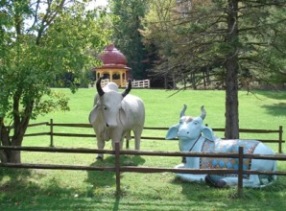
Welcome to Brijabasi Spirit
Thank you for taking the time to visit the New Vrindaban community blog. Think of visiting our blog as making a virtual pilgrimage.
Hare Krishna Hare KrishnaKrishna Krishna Hare Hare
Hare Rama Hare Rama
Rama Rama Hare Hare
"May cows stay in front of me; may cows stay behind me; may cows stay on both sides of me. May I always reside in the midst of cows."
Hari Bhakti-vilas 16.252

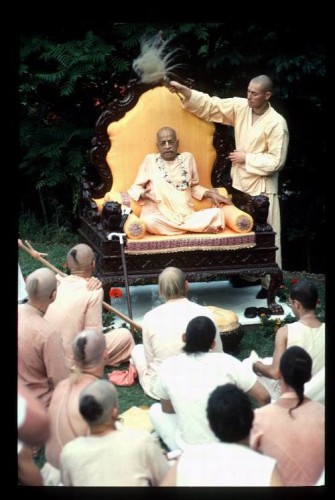





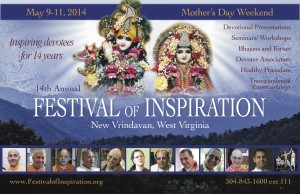
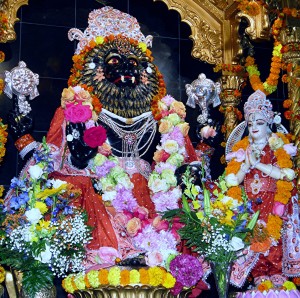
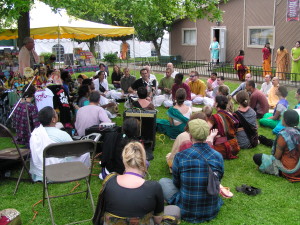
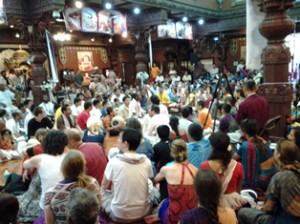


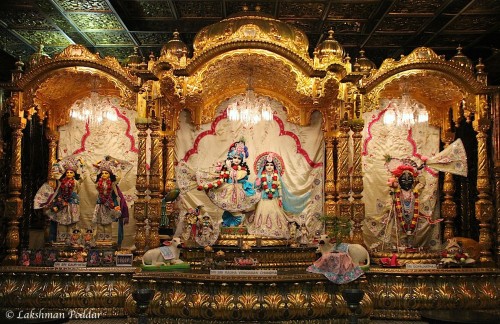




Recent Comments